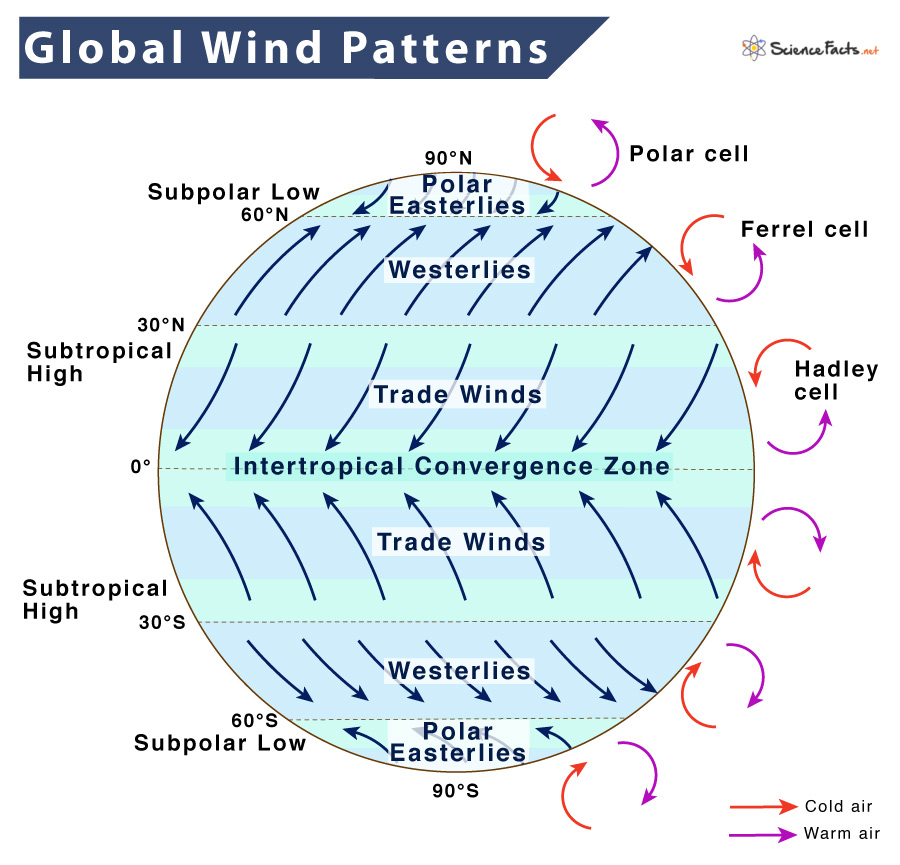
There are several kinds of wind blowing across the surface of the Earth, depending on the origin, destination, and distance traveled, among other factors. These are called prevailing or planetary winds. Global winds are one such type of wind.
Global winds are winds that develop in belts distributed all around the world. Like local winds, the leading cause of global winds is unequal heating of the atmosphere, causing a difference in air pressure.
Earth is hottest at the Equator and cooler toward the poles. In the area near the Equator, the sun is overhead for most of the year. As a result, the warm air rises and moves towards the poles. This phenomenon creates a low-pressure zone near the equatorial area called the Equatorial Low-Pressure Zone, also known as the Intertropical Convergence Zone (ITCZ). At the polar front, the cooler air sinks and moves back towards the Equator.
Almost 30° north and 30° south of the Equator, this air cools and descends to create high-pressure zones called Subtropical High-Pressure Zones. Cold air at the poles descends and creates Polar High-Pressure Zones. The cold polar air moves at about 60° north and south towards the Equator and starts rising.
This unique, permanent movement of winds across the surface of the Earth due to permanent air pressure zones creates a distinct pattern known as global wind patterns or global wind systems.

However, global winds do not move directly from north to south or south to north due to the rotation of the Earth. All winds in the Northern Hemisphere curves to the right as they move. Contrastingly, winds appear to curve to the left in the southern hemisphere. This apparent shift in the path of the wind moving about the Earth’s surface due to the Earth’s rotation is called the Coriolis Effect.
The global movement of air on the Earth in the three atmospheric convection cells is summarized below:
| Convection Cell | Location | Air Movement | Direction of Air | Wind Name |
|---|---|---|---|---|
| Hadley Cell | 0° to 30° latitude north and south | Rising at the Equator, sinking at 0° to 30° north and south | Towards the Equator | Tropical Easterlies (Trade Winds) |
| Ferrel Cell | 30° to 60° latitude north and south | Rising at 60° north and south, sinking at 30° north and south | Towards the poles | Prevailing Westerlies |
| Polar Cell | 60° to 90° latitude north and south | Rising at 60° north and south, sinking at 90° north and south | Towards the Equator | Polar Easterlies |
Thus the pattern of global winds is affected by:
As we now know, three types of prevailing winds on the Earth form three major global wind belts created due to the Coriolis Effect. They are named based on their origin and the area where they blow. We will now describe them in more detail.
Location – 0° to 30° Latitude
They are persistent winds that blow westward and toward the Equator from the subtropical high-pressure belt. Trade Winds finally converge at an area near the ITCZ, producing a narrow band of clouds, and thunderstorms encircle portions of the globe. It is more robust and consistent over the oceans than the land, often producing partly cloudy sky conditions characterized by shallow cumulus clouds or clear skies.
Most tropical storms, including hurricanes, cyclones, and typhoons, develop as trade winds.
Location – 30° to 60° Latitude
They are moist prevailing winds that blow from the subtropical high-pressure belts towards sub-polar low-pressure belts. Westerlies come from the southwest in the Northern Hemisphere and the northwest in the Southern Hemisphere.
Westerlies are essential in carrying the warm, equatorial winds to the western coasts of continents.
Location – 60° to 90° Latitude
They are dry, cold prevailing winds that blow from the high-pressure areas of the polar highs in both hemispheres. They flow towards low-pressure areas within the Westerlies at high latitudes. Cold air subsides at the pole creating high pressure, creating a northward flow of wind towards the Equator in the southern hemisphere. The flow is then deflected westward by the Coriolis Effect. Thus, these prevailing winds blow from the east to the west.
Since the winds originate in the east, they are then known as easterlies.
The global wind belts are associated with typical weather conditions, and the prevailing winds lead to seasonal climatic changes in many places on Earth. All low-pressure areas are associated with high precipitation (tropical rainforests), and all high-pressure areas are associated with arid climates (deserts).
The polar jet stream or the jet stream blows high up in the atmosphere where the two cells meet. They are fast-moving air currents at the boundary between the troposphere and the stratosphere.
They also develop due to the unequal heating of the Earth’s surface, creating a vast temperature difference between two air masses. Jet streams circle the planet, mainly from west to east, but the flow often shifts to the north and south. The polar jets are the strongest jet streams that blow between about 30°N and 50° to 75°N. They blow towards the south in the winter and north in the summer.
Ans. No. Deep currents are caused by the moon’s gravity, the Earth’s rotation, and the movement of the tectonic plates.
Q.2. Global winds over the United States blow in which direction?Ans. Since prevailing westerlies dominate most of the United States, they blow from the southwest.
ReferencesArticle was last reviewed on Thursday, February 2, 2023